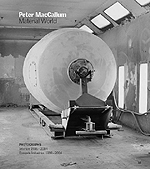
|
Lorna Mills and Sally McKay
Digital Media Tree this blog's archive OVVLvverk Lorna Mills: Artworks / Persona Volare / contact Sally McKay: GIFS / cv and contact |
View current page
...more recent posts
I will be offline for a spate (moving house). Back next week around Wednesday.



Simpleposie and many others are petitioning the Canada Council in protest against their changes to the individual artists' grants. There is a really compelling and articulate letter against the new mandate written by PAARC, (Pacific Association of Artist Run Centres), that serves as an excellent rallying cry. I read through the near-report at the CC website a couple of weeks ago, and found myself puzzled rather than outraged. I heard by gossip that the new agenda is intended to redirect funds in order to serve senior artists who are retiring from teaching positions, etc. I have NO IDEA if this is true, and if it is... I have NO IDEA if that is a good or a bad thing. I am also supremely curious, the gossip aside, to know: are there any artists out there who like the proposed changes? Knowing that the council has recently instituted a grant for private, commercial galleries(!), and knowing that current political trends indicate a solid retreat from socialism, I would venture a guess that the new proposal is not great news for the average-artist-on-the-street. As AARCO says in their open letter: " One of the dangers in their new proposal is the shift in the focus of granting criteria, away from creative process towards market-certified product." This sounds baaaad to me. But is it the only perspective? At the same time, "The Canada Council for the Arts has called on Canadians to send all levels of government a clear message about the positive impact the arts have on their communities," due to "advocacy [being] needed to promote value of arts." I think we gotta shit or get off the pot on this business of articulating the value of our practice. And somehow I don't feel qualified to sign that petition just yet. What does everybody else think?
tomorrow!
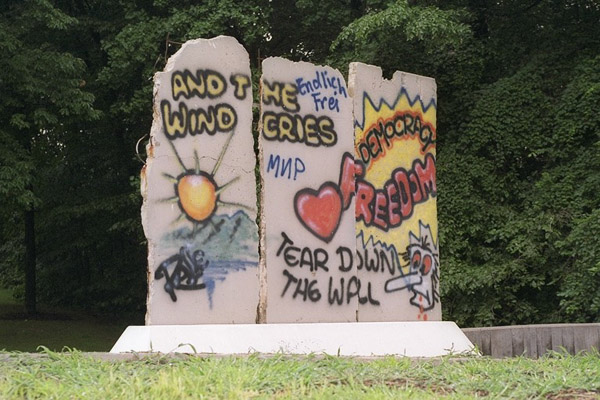 Blake Fitzpatrick (a contributor to the Peter MacCallum book mentioned above) has teamed up with fellow photographer Vid Ingelvics on an interesting exhibition about the Berlin Wall that is on at the Goethe Institute in Toronto right now. From the artists' statement: Our interest in the after-life of the Wall has been to reconsider it as a kind of post-monument. We acknowledge the Wall's continuing material existence and the private and public transformations its fragments have undergone. The exhibition at the Goethe Institute in Toronto specifically marks the 15th anniversary of the fall of the Berlin Wall by tracing some of its fragments to the epicenter of the Cold War "victory" -- Washington, D.C.The show consists of large scale photographs of slabs of wall as they stand in parks and public places in Washington. There are also three big macro close-up shots of souvenir splinters of the wall belonging to American diplomats and a US State Department employee. In a move of superb irony dust gathered from a slab of the wall in Freedom Park, Arlington, VA is displayed on a plinth. In another, a printout of an email from the CIA that emphatically denies the artists information about or images of the wall-chunk on CIA property is displayed with a photograph (the same on posted here) of the same piece, downloaded from the CIA's virtual tour online. Stephen Morris has posted a website on the workshop about emergent and self-organising patterns that I recently attended. There are good, accessible descriptions of the phenomena online, and I won't try to duplicate them here. However, to test myself I will try to briefly introduce the topic: emergent patterns occur in nature. Some examples are: a zebra's stripes, wave patterns in the sand, mud cracks, ripples on an icycle, the self-sorting of sand on the beach, and the develoment of cusps as waves crash onto the shore. These patterns emerge as the result of driving forces. Instabilities or irregularities such as small bumps or frictions set off a pattern that self-perpetuates and grows in ways that cannot be easily calculated or mathemtically predicted, thus leaving the realm of linear phsyics and becoming non-linear. The term "emergent" means that the behaviour of the pattern is not evident from the beginning, but emerges from internal states in ways we could never have guessed. "Self-organized" means that external forces don't imply the pattern, but rather there is an internal agent at work. Emergent patterns also occur in the lab, of course, under controlled conditions. The pictures of Zeina Khan's rotating grains that I posted (1 / 2 / 3 / 4) the other day were from just such an experiment. Stephen Morris started off the workshop by clearly distinguishing his branch of physics, which studies macroscopic phenomena in the real world of instability and classical forces, from that of theoretical physics which studies abstractions. There is clearly some fractious feeling between experimentalists and theorists, which is entertaining for those of us on the outside. For a lay person like me, however, the experiments at the nonlinear lab provide all kinds of food for abstract thought. Of course, even Morris himself and the graduate students that participated (Zeina Khan, Wayne Tokaruk, and Michael Rogers) expressed at times a romantic enthusiasm for both the aesthetic experience of emergent patterns, and the lofty extrapolations they suggest, such as the notion that life itself may indeed be generated in this manner. The compelling differences between organic and inorganic systems are diminished, (maybe all it comes down to is complexity?), and the question of whether something lives is less interesting that what shapes it forms itself into. In these studies, the relationship between abstraction and meaning seems to be very tight. Pattern is a shape, or form, a recognizeable and pleasing aesthetic experience. But it is also evidence of physical phenomena. Can I call an emergent pattern an image? It functions as an image when our conscious minds perceive it. The human power of abstraction is required to "read" or "translate" the image, and it is this relationship that generates meaning. People generate images as a tool for explaining the Universe. The Universe generates images as a result of its existence. The dpi in Zeina Khan's digital photographs of her sand patterns are data points. The image itself is fed directly into a meaningful computation in the language of mathematics. In a recent talk at the Perimeter Institute, philosopher of science James Robert Brown made the radical claim that in mathematics, images can be more that just illustration, but can stand as evidence, as mathematical proofs. He equates the making of images with thought experiments in physics. In the case of the latter, no actual external image is required, but the mind undertakes an act of abstraction from the phenomena, a representation of events. On the surface, it is funny in an art context to talk about abstraction and representation as the same activity. But this is exactly what interests me. More on this soon... The latest Goodreads bulletin is on artist-run culture. Timothy Comeau has posted a very interesting article by AA Bronson of General Idea, first published in 1983, Andrew J. Patterson's preface to our book Money Value Art, and a link to the discussion on this blog in September. I'm really glad to see artist-run culture under the bell-jar right now. There is an article on the topic in the current C Magazine by Emily Vey Duke, and a piece on Art Metropole coming soon in Art On Paper magazine by Micah Toub. AA Bronson's essay is a good history, delivered with a tongue-in-cheek biblical tone: ...it was natural to call upon our national attributes - the bureaucratic tendency and the protestant work ethic - and working together, and working sometimes not together we laboured to structure, or rather to untangle from the messy post-Sixties spaghetti of our minds, artist-run galleries, artists' video, and artist-run magazines. And that allowed us to allow ourselves to see ourselves as an art scene. And we did.Throughout the essay he returns again and again to the refrain of Canadian engagement with bureaucracy and protestant work ethic. I can relate, being endowed with a does of both of those traits. But AA was writing in 1983, which is starting to seem like a long time ago. I wonder what he would say now to the question: what engine fuels artist-run culture today? As anyone currently involved with ARCs (like Bronson) is keenly aware, there is a massive difference between doing the tedious grunt work to make your own project happen, and managing to inspire a team of young, creative employees. Emily Vey Duke's essay is fabulous. I'm tempted to keyboard the whole thing and post it, but of course that would be stealing. She and partner Cooper Battersby are video artists who made their name speaking poetically to the youthful state of "Being Fucked Up." (I love this video.) Vey Duke is now an arts administrator, the new director of a Halifax artist-run centre called the Khyber Centre for the Arts. This represents a shift: When I first decided to be an artist, I had an incredible sense of urgency about my work. I had to express myself to others because I felt unbearably alone. It worked. People understood. Now I don't feel alone as often or with as much intensity. Instead, I spend my time trying to re-conceptualize my job as director of a "regional" Artist-Run Centre...to make it feel even a tiny bit pressing.And she succeeds! Halifax is a raw city when it comes to interracial politics. The catastrophic demolition of Africville hangs over everyone, and there is a constant tension in the "shady" neighbourhoods of the North End between emerging art-types and established poor and working class. The racial divide is not absolute, but it is visible. Vey Duke draws out this urban friction through a personal incident, and ends her article with a call: There is urgency here. It is an urgent matter that I find ways to be white that don't contribute to ... rage and alienation...The Khyber may flounder and fail; I may never make another experimental art video. Both those things would sadden but not ruin me. In this other area, there is no margin for error. I have to act different in a way that keeps Black teens out of jail.I'm grateful to Goodreads for posting Bronson's article and furthering this discussion. I have been thinking that the onus for inspiring young artists-as-bureaucrats lies with the older generation. After all, they need employees who will put in extra hours and excited, fresh, young board members to administer the institutions they created. But of course I've got it backwards. It is the job of people like Vey Duke, who see where urgency lies, to push the institutions into the shapes that can apply to the pressing Canadian art needs of today. Mabye the way to revitalise artist-run culture is to start by asking, what's missing?...and bring the very people who are missing it on board. And nobody has to toss out the great Canadian legacies of bureaucratic tendency and protestant work ethic.   
Ontario is in danger of passing a mandatory helmet law for cyclists. This sucks. Helmet legislation decreases bicycle use, thereby cause big time health and safety problems. Besides that, it's parochial and insulting and sends a strong message that the government doesn't like bikes. Cyclists need better street design, side-guards on trucks, reduction in speed, bike lanes, and a political environment that welcomes the bicycle as a beneficial and progressive transportation mode. If you truly want to create a culture of safety, foster a culture of cyclists--- people who get excercise, don't pollute, and, compared to cars, hardly ever kill or injure anybody else. From the National Post: "At its core, I think this bill is really about creating a culture of safety in this province," [John] Milloy told a news conference.From The Hammer: "We have to keep the people of Ontario safe. This is what we have to do to ensure compliance and institute a culture of safety in our province," said an unrepentant Irving Halitosis, Minister for Screwing You Over , the provincial ministry responsible for the bill's enforcement. "I mean, you can't have people running around and eating dinner without helmets on. What if a fish stick jumped up off your plate and whacked you in the forehead? It happened to me, and it's not pretty. I was off work for three months."People to contact: Jeff Leal, M.P.P., jleal.mpp.co@liberal.ola.orgmore info at ARC  "In ordinary Newtonian fluids (those that do not exhibit shear thickening or shear thinning) the wave patterns include ones with 1-fold symmetry (stripes), 2-fold symmetry (squares), 3-fold symmetry (hexagons) as well as higher orders of symmetry." Above quote and image are taken from the nonlinear physics pages at University of Toronto. I'm going to a workshop this weekend for artists on physics and patterns, organised by Subtle Technologies. This stuff above with patterns in liquids is the realm of Wayne Tokaruk. Michael Rogers works with patterns in chemical reactions and Zeina Khan (see image below) is the master of segregation patterns in sand. These three are all studying with Stephen Morris, who will conduct the workshop. I'll no doubt have more to report later. Cool pictures, n'est-ce pas? 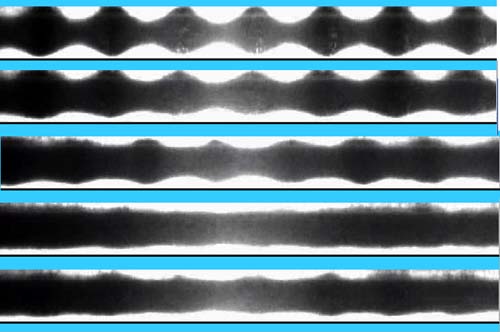
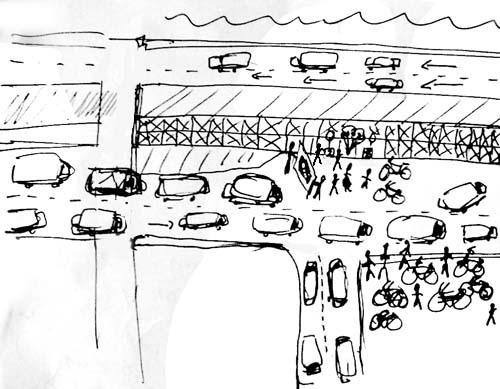 When we arrived this morning, the sister, a gregarious little spitfire of a woman, was already there with her bicycle. There were about eight neighbours as well, everyone with flowers and tears. Normally we would take the street and block a lane of traffic for a minute of silence, but the sister was calling the shots and asked us to put all our bikes together on the sidewalk. I understand this impulse. Streets full of moving cars often seem inviolable, even when they have recently interrupted your life by taking away a loved one. It takes experience to know and remember that breaking into traffic flow is surprisingly easy, and claiming street space, even temporarily, is empowering. We stood together on the corner with our sad banner ("a cyclist was killed here last week"), and held a minute of silence, watching the cars whizz by. Then the sister asked me if I would put my flowers on the fence, across the two lanes of speeding traffic. Of course I agreed, eager to violate that damned street. A few of us crossed and stood in the far traffic lane, tying up flowers to the fence. Once we had broken the seal, the sister and neighbours struck out into the road as well! We held up the banner to block the lane and diverted traffic around the scene. The mourners took their time, standing on the road to pin up flowers. The sister, crying openly now, put out candles and lit a little shrine. I felt very glad to be there, helping provide a little pocket of temporary safety, on this otherwise fatally fast street, so that a woman could mourn her sister on the spot where she died. Afterwards we were all invited back to the apartment where the sisters lived nearby, and were served wheat cookies in the shape of tiny pigs that the cyclist had baked before she was killed by cars.
Excerpt from Ken Wiwa's "Look Out: There's a Flu Under Every Bush," from Saturday's Globe and Mail: ... [T]here is a school of thought that hopes Mr. Bush gets a second term, and I've already enrolled in that program. 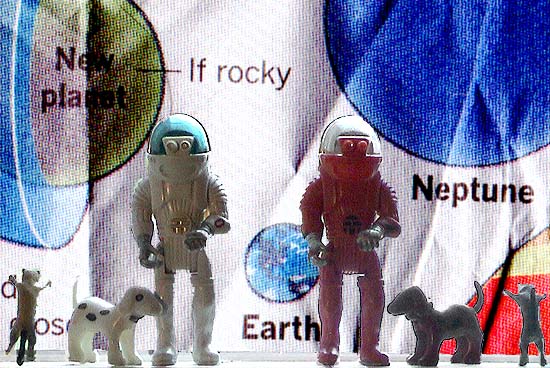 |
|||||||||||
